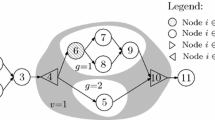Abstract
Machine selection and operation allocation is a multi-criteria decision-making problem which involves the consideration of both qualitative and quantitative factors. Thus, a hybrid model integrating the knowledge-based expert system and the genetic algorithm may be effectively applied to the decision problem. This paper proposes a two-step approach where suitable machines for every operation in a work center is selected and optimized as a whole to obtain the optimum machine park. The first step of the model determines the suitability of each machine type for every operation using the knowledge-based expert system. The second stage searches through the solution space to find the optimal machine park with the use of a genetic algorithm. A real-life case study at an outdoor advertisement manufacturing company demonstrates the applicability of the model.
Similar content being viewed by others
References
Felix TSC, Niraj K (2009) Effective allocation of customers to distribution centres: a multiple ant colony optimization approach. Robot CIM-Int Manuf 25:1–12
Davies AJ, Kochhar AK (2000) A framework for the selection of best practices. Int J Oper Prod Manage 20(10):1203–1217
Saygin C, Chen FF, Singh J (2001) Real-time manipulation of alternative routeings in flexible manufacturing systems: a simulation study. Int J Adv Manuf Technol 18:755–763
Famili A (1990) Integrating learning and decision-making in intelligent manufacturing systems. J Intell Robot Syst 3:117
Gunasekaran A, Ngai EWT (2007) Knowledge management in 21st century manufacturing. Int J Prod Res 45(11):2391–2418
Vosniakos GC, Davies BJ (1991) Knowledge-based selection and sequencing of hole-making operations for prismatic parts. Int J Adv Manuf Tech 8(1):9–16
Cheng K, Bateman RJ (2008) e-Manufacturing: characteristics, applications and potentials. Prog Nat Sci 18:1323–1328
Cimren E, Catay B, Budak E (2007) Development of a machine tool selection system using AHP. Int J Adv Manuf Technol 35:363–376
Albayrakoglu M (1996) Justification of new manufacturing technology: a strategic approach using the analytical hierarchy process. Prod Invent Manage J 37(1):71–77
Wabalackis RN (1988) Justification of FMS with the analytic hierarchy process. J Manuf Syst 7(3):175–182
Mohanty RP, Venkataraman S (1993) Use of the analytic hierarchy process for selecting automated manufacturing systems. Int J Oper Prod Manage 13(8):45–57
Lin Z-C, Yang C-B (1996) Evaluation of machine selection by the AHP method. J Mater Process Technol 57:253–258
Sarkis J (1997) Evaluating flexible manufacturing systems using data envelopment analysis. Eng Econ 43(1):25–46
Rao RV (2006) A decision-making framework model for evaluating flexible manufacturing systems using digraph and matrix methods. Int J Adv Manuf Technol 30(11–12):1101–1110
Karsak EE, Kuzgunkaya O (2002) A fuzzy multiple objective programming approach for the selection of a flexible manufacturing system. Int J Prod Econ 79(2):101–111
Karsak EE, Tolga E (2001) Fuzzy multi-criteria decision making procedure for evaluating advanced manufacturing system investments. Int J Prod Econ 69(1):49–64
Liu ST (2008) A fuzzy DEA/AR approach to the selection of flexible manufacturing systems. Comput Ind Eng 54(1):66–76
Tabucanon MT, Batanov DN, Verma DK (1994) Intelligent decision support system (DSS) for the selection process of alternative machines for flexible manufacturing systems (FMS). Comput Ind 25:131–143
Chan FTS, Jiang B, Tang NKH (2000) The development of intelligent decision support tools to aid the design of flexible manufacturing systems. Int J Prod Econ 65(1):73–84
Shang J, Sueyoshi T (1995) A unified framework for the selection of a flexible manufacturing system. Eur J Oper Res 85(2):297–315
Talluri S, Whiteside MM, Seipel SJ (2000) A nonparametric stochastic procedure for FMS evaluation. Eur J Oper Res 1(3):529–538
Chtourou H, Masmoudi W, Maalej A (2005) An expert system for manufacturing systems machine selection. Expert Syst Appl 28(3):461–467
Masmoudi W, Chtourou H, Maalej AY (2007) Labour and machine sizing through a simulation-expert-system-based approach. Simul Model Pract Th 15:98–110
Feyzoğlu O, Pierreval H, Deflandre D (2005) A simulation-based optimization approach to size manufacturing systems. Int J Prod Res 43(2):247–266
Cheng T, Feng C (2003) An effective simulation mechanism for construction operations. Automat Constr 12:227–244
Deng PS, Tsacle ES (2000) Coupling genetic algorithms and rule-based systems for complex decisions. Expert Syst Appl 19:209–218
Mirhosseyni SH, Webb P (2009) A hybrid fuzzy knowledge-based expert system and genetic algorithm for efficient selection and assignment of material handling equipment. Expert Syst Appl 36:11875–11887
Kim K (2006) Artificial neural networks with evolutionary instance selection for financial forecasting. Expert Syst Appl 30:519–526
Wong TN, Chan LCF, Lau HCW (2003) Machining process sequencing with fuzzy expert system and genetic algorithms. Eng Comput Ger 19:191–202
Lawrynowicz A (2008) Integration of production planning and scheduling using an expert system and a genetic algorithm. J Oper Res Soc 59:455–463
Hamada K, Baba T, Sato K, Yufu M (1995) Hybridizing a genetic algorithm with rule-based reasoning for production planning. IEEE Intell Syst 10(5):60–67
Hazir O, Gunalay Y, Erel E (2008) Customer order scheduling problem: a comparative metaheuristics study. Int J Adv Manuf Technol 37:589–598
Gao J, Gen M, Sun L (2006) Scheduling jobs and maintenances in flexible job shop with a hybrid genetic algorithm. J Intell Manuf 17:493–507
Author information
Authors and Affiliations
Corresponding author
Rights and permissions
About this article
Cite this article
Guldogan, E.U. An integrated approach to machine selection and operation allocation problem. Int J Adv Manuf Technol 55, 797–805 (2011). https://doi.org/10.1007/s00170-010-3063-y
Received:
Accepted:
Published:
Issue Date:
DOI: https://doi.org/10.1007/s00170-010-3063-y




